Park Focus: Evergreen Park
Krissy Elkins, Workday Coordinator
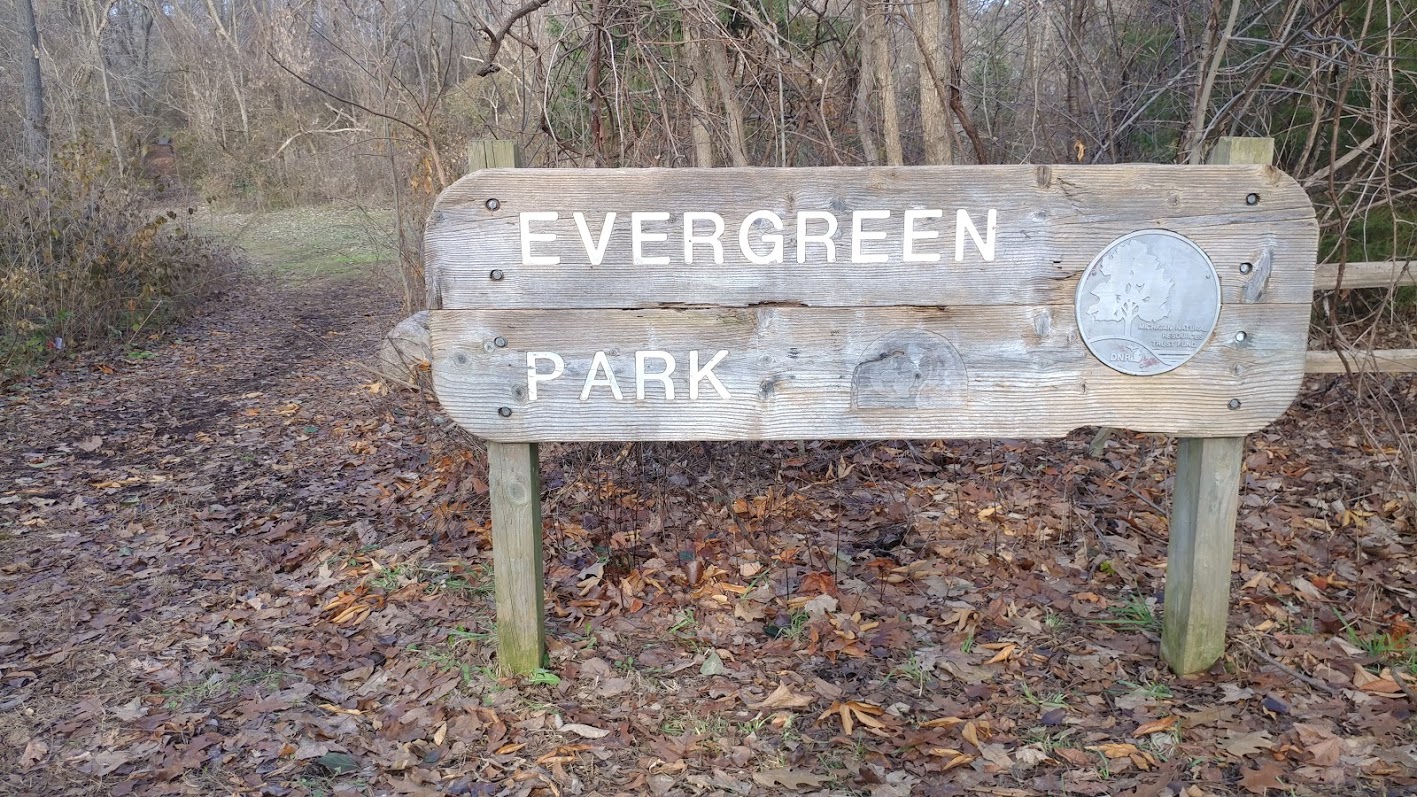 Evergreen Park is a small park with a big history. Located on an irregularly shaped 3.5-acre lot on the western edge of town, Evergreen Park is cherished by its neighbors. One long-time park patron and neighbor just recently took on the job of becoming the park's first NAP Park Steward!
Evergreen Park is a small park with a big history. Located on an irregularly shaped 3.5-acre lot on the western edge of town, Evergreen Park is cherished by its neighbors. One long-time park patron and neighbor just recently took on the job of becoming the park's first NAP Park Steward!
Meg Szczygiel first heard about Evergreen Park when she, her husband, and her kids moved to Ann Arbor in 1992. The neighborhood, called “The Evergreens," was built in the late 20's according to the old map Meg received when she moved in, dated 1929. The choice to move here was easy; low interest rates due to the Gelman Plume made the area affordable for Meg and her family, which allowed her kids to attend Ann Arbor's esteemed public schools.
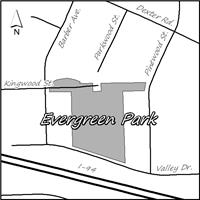
In the original plans for the neighborhood, the north-south street called Parkwood veered south and connected to Valley Drive. Additionally, Kingwood Street connected through to Pinewood Street, completing the grid pattern of the neighborhood. Houses were built along Parkwood, lining both sides of the street. There was a tiny piece of land on the northeast corner of Kingwood and Barber that was designated to be the neighborhood park for the new development. Meg suspects the houses were hard to fill in the midst of the Great Depression. Eventually, the houses along the southern half of Parkwood were torn down and the property became what we know as Evergreen Park. As for that tiny piece of land across Kingwood Street, it is still city property and adds to the unique shape of the park.
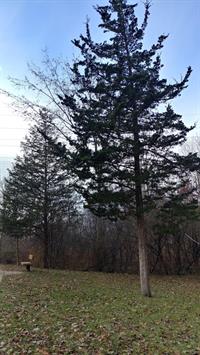 Many remnants from the land's previous life remained on site for decades. Even today, the main path through the park, uncommonly and unnaturally straight, is thought to be what is left of the old stretch of Parkwood Street. Meg has found old kitchen appliances like refrigerators and ovens as well as leftover cement blocks from the houses. Ornamental garden plants cling to the ground from years past landscaping projects.
Many remnants from the land's previous life remained on site for decades. Even today, the main path through the park, uncommonly and unnaturally straight, is thought to be what is left of the old stretch of Parkwood Street. Meg has found old kitchen appliances like refrigerators and ovens as well as leftover cement blocks from the houses. Ornamental garden plants cling to the ground from years past landscaping projects.
Much of the land in the park is low and wet. A temporary pool borders the artificially raised main path where Meg hears choruses of frogs in springtime. The landscape is pimpled with mounds of soil, little hills, and brus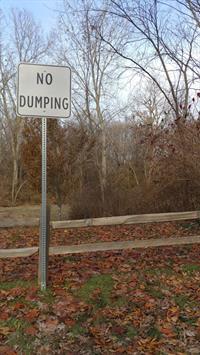 h piles, as well as depressions, holes, and ditches. Struggling with dumping issues and invasive species, city staff have installed a “No Dumping" sign at one of the three park entrances, which has helped in recent years.
h piles, as well as depressions, holes, and ditches. Struggling with dumping issues and invasive species, city staff have installed a “No Dumping" sign at one of the three park entrances, which has helped in recent years.
Navigating Evergreen Park, even though it is small, is a bit tricky. The property boundaries are unclear and unauthorized trails weave through the woods, most of which quickly fade into an overgrown thicket of honeysuckle, buckthorn, and wintercreeper. A few years ago, some neighborhood kids spent countless hours building a loop trail through the woods, intersecting the main path. While no longer passable, the banked corners of this trail can still be seen today. There is even a viewing bench off this loop trail; unfortunately, the only view from this bench is twigs and branches of invasive shrubs.
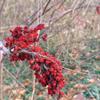 With the help of Meg and support from the community, NAP is excited to spend more time in this neighborhood park. Even though invasive species have aggressively established, native plants are fighting back. Oaks, cherries, and tulip trees mingle in the forest canopy while goldenrods sway in the breeze along Valley Drive. We are excited to work together to make space for native plants and wildlife to thrive!
With the help of Meg and support from the community, NAP is excited to spend more time in this neighborhood park. Even though invasive species have aggressively established, native plants are fighting back. Oaks, cherries, and tulip trees mingle in the forest canopy while goldenrods sway in the breeze along Valley Drive. We are excited to work together to make space for native plants and wildlife to thrive!
To help us fight the invasive plants here, join us on Sunday, April 5, from 1 to 4 p.m. for our workday in Evergreen Park.
Coordinator's Corner
David Borneman, Natural Area Preservation Manager
Over the next few months, Ann Arborites may be seeing smoke on the horizon when NAP is out doing one of our controlled, or “prescribed" burns. We've been burning for the past 26 years, since the earliest days of NAP. Fire is probably our single-most effective and important ecological management tool. Among other things, it discourages most invasives and gives a competitive advantage to most natives. Spring has always been the “high, holy season of burning" for many of us in this profession. Some years we'll also have a short “reprise" in the fall, after the oak leaves fall and things go dormant.
But for years, the prescribed fire community nation-wide has been talking about the benefits of growing season burns. Historically, we know that Native Americans burned at different seasons of the year for different purposes. And a common mantra among fire practitioners today is “pyro-diversity creates biodiversity." The theory is that if we always burn at the same time of year, we only benefit one group of plants and animals. Burning on a more varied schedule, with diversity in frequency and intensity, leads to greater diversity of native species. Additionally, because one of our primary burn objectives is to discourage invasive shrubs, it makes sense to time those burns when the shrubs are most easily killed with fire, which is not during the dormant season.
That all sounds good in theory. The challenge has been actually making it happen. There are many good reasons to burn in the cool months of March and April before things green up: less smoke (always a major concern); fewer park users, and fewer open windows in park neighbors' houses; fewer wildflowers blooming; and fewer animals active. Logistically, it's also easier to do all of our burning during one brief but intense spring burn season. After weeks of preparation in late winter, we finally have everything ready for the first dry spring day. Other activities get put on hold and it's “All hands on deck!" at the NAP office. The burn gear is ready to go at a moment's notice. Water tanks are full in the truck beds. And staff keeps a constant, close eye on weather forecasts and on-site conditions. It's an intensity that's hard to maintain for more than 6-8 weeks. But we're an efficient burn operation during that burst. After that we get busy with garlic mustard and other invasives, volunteer workdays, wildlife surveys, etc…
It would be harder to stay “geared up" or to “re-gear" just so we could do a couple burns here and there during the growing season, but that's what we're hoping to start doing, especially in August or September, after nesting season, during the driest parts of the summer. Logistically there will be challenges. But we think the ecological benefits are worth it. Questions about this? Concerns? Interested in learning more about the benefits of growing season burns? Feel free to contact us. We're still trying to work out the logistics, but we're happy to hear your thoughts and include you in the conversation. Look for our smoke this summer!
Chorusing Frogs of Spring
George Hammond, Field Biologist
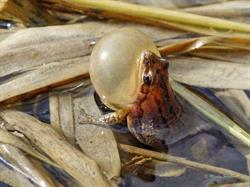 Just as the warming days of spring inspire birds to sing during the day, frogs start to sing (well, call anyway) after dark. Here in southeast Michigan we have 13 species of frogs and toads, and at least eight or nine of them will be calling in Ann Arbor parks this year. Each species has its own unique call, and sing in their choruses at different times and places.
Just as the warming days of spring inspire birds to sing during the day, frogs start to sing (well, call anyway) after dark. Here in southeast Michigan we have 13 species of frogs and toads, and at least eight or nine of them will be calling in Ann Arbor parks this year. Each species has its own unique call, and sing in their choruses at different times and places.
Frogs call for one main reason: to attract a mate. In the species found here, males do nearly all the calling. They gather in ponds and pools, or along the river, trying to be chosen by a female. Each species has a unique “advertisement call" that males make to attract females and show off their qualities as potential mates. Males listen to each other, adjusting their timing and assessing the competition. They sometimes push and shove for the best calling spots, but a strong enough call may be enough to keep weaker males at bay. When females arrive, they are ready to lay eggs. They try to choose the best males, but when there are many, many frogs in the pond at once, things can get a bit hectic. Males will try to grab on to anything that looks like a female, and they are not choosy. Many species have a “release call" that males use to tell another male, “Get off me, I'm a male too!" Often a female chooses a male and lays her eggs in a single night, but males will linger in hopes of attracting another female.
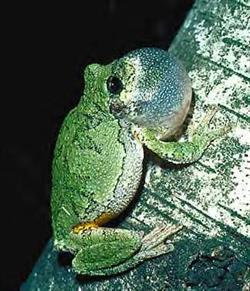 The timing of frog calling depends on the weather and on the species. Some species call very early in the spring even while there is still some ice on the ponds. Some call later in the spring and a few are still calling in early summer. All frogs call mainly at night, so they can't be seen by predators, and will call most strongly when it is relatively warm and the air is damp. In some species, Wood Frogs for example, all the calling and egg-laying happens in a very short period of time, just two or three nights at any one pond. In other species, like Spring Peepers, American Toads, and Green Frogs, males may call for several weeks. The first frogs to call, starting as early as mid-March, are Wood Frogs, Spring Peepers, and Chorus Frogs. All three use very temporary pools that dry up in late summer, and they lay eggs as soon as they can. Later in the spring, from mid April through May, American Toads, Gray Treefrogs, and Leopard Frogs are calling. They use temporary pools too, but also breed at the edges of permanent waters, if there is enough vegetation for their tadpoles to hide in. Finally in mid-to-late-May, Green Frogs and Bullfrogs start to call, and they may carry on into July. They need permanent waters with lots of vegetation, because their big tadpoles need more than one summer to finish growing.
The timing of frog calling depends on the weather and on the species. Some species call very early in the spring even while there is still some ice on the ponds. Some call later in the spring and a few are still calling in early summer. All frogs call mainly at night, so they can't be seen by predators, and will call most strongly when it is relatively warm and the air is damp. In some species, Wood Frogs for example, all the calling and egg-laying happens in a very short period of time, just two or three nights at any one pond. In other species, like Spring Peepers, American Toads, and Green Frogs, males may call for several weeks. The first frogs to call, starting as early as mid-March, are Wood Frogs, Spring Peepers, and Chorus Frogs. All three use very temporary pools that dry up in late summer, and they lay eggs as soon as they can. Later in the spring, from mid April through May, American Toads, Gray Treefrogs, and Leopard Frogs are calling. They use temporary pools too, but also breed at the edges of permanent waters, if there is enough vegetation for their tadpoles to hide in. Finally in mid-to-late-May, Green Frogs and Bullfrogs start to call, and they may carry on into July. They need permanent waters with lots of vegetation, because their big tadpoles need more than one summer to finish growing.
Since each species has its own call, and they are pretty easy to tell apart, we can use the choruses to monitor frog populations. Natural Area Preservation has been organizing volunteers to check on the frogs in our parks since 1995. Every spring, volunteers go out at night to listen to the choruses and record the species they hear. This survey is one of several wildlife inventories that we organize with volunteers every year. We also look for salamanders (much harder, they are silent!), breeding birds (if you know bird songs, we need your help!), butterflies (literally a walk in the park), and turtles (we spot them basking on sunny days). Please check the calendar on page four for training dates if you are interested, and check out our website at a2gov.org/NAP for more information about our wildlife work.
NAPpenings
Thank You!
Many thanks to the gropus who volutneered with NAP recently. We could not make such a difference without you!
Big Brothers Big Sisters
EMU Beta Alpha Psi
EMU Early College Alliance
EMU Greek Life
Girl Scouts Troop 40035
Mercedes Benz R&D North America Noble Volunteers
Sustainable Living Experience
UM Circle K
UM Delta Sigma Pi
UM Engineering Honors Program
UM Michigan Community Scholars Program
UMSI (UM School of Information)
City Nature Challenge 2020
Over 250 cities around the world will be competing to see who can make the most observations of nature, find species, and engage people in the 2020 City Nature Challenge! In Ann Arbor, citizen scientists will take pictures of nature and try to identify the many different species that have been photographed in their community using iNaturalist, an online nature observation and identification tool. The challenge occurs April 24 through May 3rd and results will be announced on May 4th! Want to get involved or learn more? Visit citynaturechallenge.org. and join our project on iNaturalist.org by searching “City Nature Challenge 2020: Ann Arbor."
Nature Walks with NAP and ADDL
4th Thursday, April-September
6 to 7:30 p.m.
Join us on the fourth Thursday of each month, April through September, for Nature Walks with Natural Area Preservation and the Ann Arbor District Library. Some of AADL's science tools will be available! Check our website for locations. [email protected]/NAPevents
Staff Updates
Welcome...
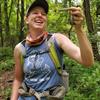 Trish Brockman, Conservation Worker
Trish Brockman, Conservation Worker
I grew up on the outskirts of East Lansing, running around in the forests and fields behind my house catching snakes, digging holes, building forts, and getting dirty. As a kid I was always fascinated by the natural world and wanted to learn more about it and how I could help protect it. I took that passion with me to college and graduated from Michigan State University with a Bachelor's degree in Fisheries and Wildlife and Zoology. Before working with NAP I spent time as a field technician with the Michigan DNR, tracking Eastern Massasauga Rattlesnakes in Michigan with MSU, conducting research on Timber Rattlesnakes in Pennsylvania for Penn State University, and serving with AmeriCorps at Leslie Science & Nature Center. In my free time I enjoy finding and photographing reptiles and amphibians, hiking, biking, illustrating and reading.
 Hannah Bradshaw, Outreach Assistant
Hannah Bradshaw, Outreach Assistant
I am currently a student at the University of Michigan, and prior to coming to NAP I've spent time working at the UM Museum of Natural History and the Washtenaw County Conservation District. I love the outdoors and open spaces, so in my free time I like to be outside with my dog Blue or reading a good book. I am grateful to be a part of such a passionate team here, filled with truly kind people who care deeply about the work that they are doing. I'm really excited to have the opportunity to work with more volunteers here at NAP, as they're some of my favorite people to interact with and learn from.
 Nick Scobel, Conservation Worker
Nick Scobel, Conservation Worker
Since a young age, I've been fascinated with nature and wildlife. I enjoy spending much of my spare time in the woods with my camera photographing wildlife. After graduating from Central Michigan University with a degree in Natural Resources, I've worked for various agencies and organizations on an array of conservation projects. This included two years working for the University of Florida on long-term crocodilian research in the Everglades. I'm looking forward to gaining new skills and knowledge from my time with NAP.
21st Annual Garlic Mustard Weed Out Day
Saturday, May 16, 2020, 9 a.m. to noon
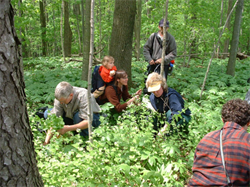 Garlic Mustard Weed Out Day is an annual tradition! On one day, volunteers hand-pull invasive garlic mustard in natural areas all around Ann Arbor! Garlic mustard is an aggressive invasive plant that can quickly crowd out native plant species and decrease biodiversity in the woods. Identifying and pulling garlic mustard is fun and easy for all ages, making this a great volunteer opportunity for families.
Garlic Mustard Weed Out Day is an annual tradition! On one day, volunteers hand-pull invasive garlic mustard in natural areas all around Ann Arbor! Garlic mustard is an aggressive invasive plant that can quickly crowd out native plant species and decrease biodiversity in the woods. Identifying and pulling garlic mustard is fun and easy for all ages, making this a great volunteer opportunity for families.
Participating Parks:
- Argo Park: Meet us at the park entrance at the corner of Amherst Avenue and Longshore Drive
- Black Pond Woods: Meet us at the entrance off Tibbits Court, off Pontiac Trail
- Cedar Bend Nature Area: Meet us at the Island Park parking lot, at the end of Island Drive
- Hannah Nature Area: Meet at the west end of Bath Street, off 7th Street, just north of West Huron Street
- Huron Parkway Nature Area: Meet at the Park Steward's house - 3470 Woodland Road, off East Huron River Drive
- Huron Hills Golf Course Woods: Meet us on Hunting Valley Road off Provincial Drive
